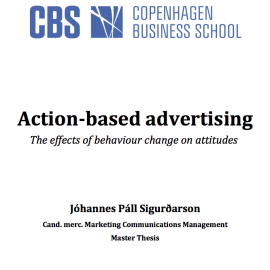Behavior Change: Why Action Advertising Works Harder Than Passive Advertising
Work
Billions of dollars are spent each year by marketers in efforts to change consumer behavior. These are often direct and overt, such as persuading consumers to consume a product over that of a competitor. Even indirect attempts, such as campaigns aimed at creating brand image and raising awareness, ultimately have the end goal of changing consumer behavior.
In the marketing and advertising industry it is usually assumed that communicating a message to a consumer in a one-way direction is all that is required to change behavior. This is despite the proliferation of both academic and commercial research into consumer motivations (e.g., Bargh, 2002; Jacoby, 1976; Tybout & Artz, 1994). Though much effort is invested into the message itself, the direction of communication is rarely questioned.
The prevalence of this approach is interesting, since alternative methods of communication to change behavior have long been developed in other industries, such as education. Two-way communication (e.g., student involvement in lectures) has long been recognised for its contribution to learning and behavior change (Gosen & Washbush, 2004). For example, a study found that children who had participated in gardening as well as receiving nutrition education had significantly higher vegetable consumption levels, in comparison with children who received nutrition education only (Parmer at al., 2009).
Problematically for marketers, the most successful ingredients of an advertising campaign are often difficult to pinpoint. However, in recent times, aided in part by an increased industry focus on digital technologies and social media platforms, ‘action’-based campaigns have demonstrated encouraging results. Campaigns such as Burger King’s Subservient Chicken, McDonald’s Name It Burger, and the Tate Modern’s Warholiser all required some form of consumer interaction, whether this was by playing a game, naming a product or transforming a photo of themselves.
Viewed through a psychological lens, these campaigns reflect various forms of experiential learning. Based on the theories of Dewey (1938) and Lewin (1947), experiential learning is defined as “the process whereby knowledge is created through the transformation of experience” (Kolb, 1984). Thus, consumers who have the opportunity to interact with, or experience, rather than passively receive a message, should be more likely to create personalized meanings and associations from this information, and then change their behavior accordingly.
There appear to be at least three significant reasons that experiential learning is effective: autonomy, discovery and personal relevance (Smith, 1980). Autonomy may circumnavigate resistance to a message, facilitate discovery, and enhance motivation. For example, in a study that measured different parenting styles of parents of 180 elementary school children, Grolnick and Ryan (1989) found that children of participative parents (e.g. where children were involved in decision making and problem solving) were more internally motivated and successful at school.
The experience of coming to a realisation oneself appears to be essential for processing and retention of information. Also, when one is personally involved in action learning, information feels more relevant and therefore, more interesting, with greater perceived consequences for oneself (Smith, 1980). Another potentially explanatory theory is that of cognitive dissonance (Festinger, 1957). Consumers may be more open to a brand once they have begun the interaction process, due to the need to maintain consistency between thoughts and behavior.
Thus far, this subject has received little empirical attention in an applied sense. Therefore, our research aims to investigate the effectiveness of action-based communication versus traditional, passive forms of communication, with effectiveness defined as a measurable change in consumer behavior. We propose that:
H1. Participants in Condition 3 will donate a higher mean amount per person to charity than Conditions 1, 2 or 4.
Methodology
Participants
A convenience sample of 181 delegates at an Australian media and marketing conference was used (Condition 1 = 94, Condition 2= 27, Condition 3= 42, Condition 4 = 18). The age range was approximately 20-65.
Materials
For each group, a video was created comprising an introduction and the experimental manipulation, led by a charity representative. Behavior change was operationalized as monetary donations to charity tins.
Condition 1 (passive/rational) viewed a verbal presentation of key factual information about the charity.
Condition 2 (passive/emotional) viewed a video montage of the charity’s activities and positive effects, accompanied by an upbeat song.
For Condition 3 (active/high personal involvement/neutral), participants were asked to create an advertising idea for the charity, by drawing an image, some words and an encapsulating ‘tagline’ on paper. The task was deliberately unguided so as to facilitate autonomy.
For Condition 4 (active/low personal involvement/neutral), participants were asked to complete some unrelated word puzzles.
All groups were supplied with a written overview of the charity’s core functions, to ensure a baseline level of understanding.
Procedure
Consent was obtained prior to conference attendance.
No random allocation was possible, since participants were required to self-allocate to one of four rooms for the following conference presentation. Participants were blind to experimental conditions (ostensibly sponsorship messages, so as to prevent demand effects). Assistants collected donations immediately after the manipulation.
Participants were debriefed the following day.
Major Findings
Results suggested that those participants in the active learning condition were likely to donate more. Condition 3 received the highest donations per person ($3.84). Following this was Condition 2 with $3.69, Condition 4 with $2.58 and Condition 1 with $2.39. A lack of data points at the individual level precluded examination of statistical significance.
Some additional participants entered the room in Condition 3 after the manipulation had begun. Attempts were made to exclude these from the dataset. We cannot rule out, however, the possibility that additional donations may have slightly inflated the mean donation per person.
Overall, the present research has yielded encouraging support for the effectiveness of action-centred communications, although logistical limitations limited the reliability of the data collected. However, given the pattern of results obtained, and robust theoretical underpinnings of our central hypothesis, we feel that this is a very strong direction for further research.
Future research is planned to replicate these findings in a more controlled environment, across a range of product categories, and across a range of types of ‘action’, and with representative populations.
In Press
Bachen, A., Ward, B., & Palermo, J. (2012). Behavior Change: Why Action Advertising Works Harder Than Passive Advertising. Working paper presented at Society for Consumer Psychology: Proceedings of the 2012 Annual Conference, Las Vegas, Nevada, February 16 – 18, Society of Consumer Psychology, USA.
References
Bargh, J.A. (2002). Losing consciousness: Automatic influences on consumer judgment, behavior, and motivation. Journal of Consumer Research, 29(2), 280-285.
Dewey, J. (1938). Logic: The Theory of Inquiry. New York: Henry Holt & Co.
Festinger, L. (1957). A theory of cognitive dissonance. Stanford, CA: Stanford University Press.
Gosen, J., & Washbush, J. (2004). A review of scholarship on assessing experiential learning effectiveness. Simulation & Gaming, 35(2), 270-293.
Grolnick, W. S., & Ryan, R. M. (1989). Parent styles associated with children’s self-regulation and competence in school. Journal of Educational Psychology, 81, 143-154.
Jacoby, J. (1976). Consumer psychology: An octennium. Annual Review of Psychology, 27, 331-358.
Kolb, D.A. (1984). Experiential learning: experience as the source of learning and development. New Jersey: Prentice-Hall.
Lewin, K. (1947). Frontiers in group dynamics: Channels of group life; social planning and action research. Human Relations, 1(2), 143-153.
Parmer, S.M., Salisbury-Glennon, J., Shannon, D., Struempler, B. (2009). School gardens: an experiential learning approach for a nutrition education program to increase fruit and vegetable knowledge, preference and consumption among second-grade students. Journal of Nutrition Education and Behavior, 41(3), 212-217.
Smith, M. (1980). Creators not consumers: rediscovering social education. Leicester: National Association of Youth Clubs.
Tybout, A.M., & Artz, N. (1994). Consumer psychology. Annual Review of Psychology, 45, 131-169.
Authors: Fritz Bachen, Brook Ward, Naked Communications, & Josephine Palermo, Deakin University



